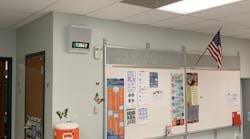Recent changes in mass notification systems have put increased power into the hands of security professionals. You can now monitor events local to your interests, send and receive messages to thousands of people, and resolve issues more quickly and accurately than ever before. And these new systems are available to any organization – small and mid-sized businesses, large enterprises, nonprofits, and member organizations of all types. When deciding on which mass notification system to deploy at your organization, or whether your current system needs upgrading, ensure the system offers the following at a minimum.
Two-way Communications
With the increased prevalence of mobile devices and easy-to-reach communication channels like text messages and app pushes, today’s emergency notification systems need to be communication systems, not just notification systems. Good systems will allow users to respond to surveys, reply to well-checks and read-receipts, send replies to incoming messages, leave voicemails and text messages for admins, and even submit a request for help with their location displayed right on your organizational map. Users can be the organization's eyes and ears during an event, and that two-way communication greatly improves event coordination.
Intuitive User Experience
During an emergency, you are typically moving at a frantic pace to protect your people and your organization, so the mass communication system needs to be easy to use, allowing you to quickly orient yourself and send your critical message in seconds. An effective system requires no training, directly integrates product tips and tutorials right into the user experience, and makes it easy for you to include more users across the organization as they will not need extensive support and guidance.
Native Mobile Applications
Most employees have mobile phones, so it’s imperative that you can leverage the power of your mass communication system from anywhere, at any time, with native mobile applications for iOS and Android phones. Mobile applications ensure that you’re never more than a few swipes and clicks away from notifying potentially tens of thousands of people -- even for global operations. The best mobile apps also have user experiences designed for audience members, allowing those people to use the app for messages, help requests, and location sharing.
Easy Data Syncing
One of the most important benefits of a mass communication solution is helping you find the right audience for each message. Your system needs to sync data automatically so things like employee turnover, office location changes, and company acquisitions don’t result in outdated people records. You should be able to automatically sync a CSV file, your Active Directory, or whatever human resources or payroll system you use for up-to-date employee data like phone number, email, and address at a minimum.
Map Views and Geofencing
By their nature, events are location-based. Office or school closures, inclement weather, an active shooter – these events all impact your immediate users. Today’s mass emergency notification systems allow you to see your people and events on a map, providing valuable insight into a user’s proximity to danger. You can use a mouse or finger to then geofence an audience, thus sending a message just to those people inside the fenced area.
Scheduling (on-duty and off-duty audiences)
Much has been made of the risk and annoyance associated with texting and calling off-duty employees. By using a communication system with integrated scheduling features, your admins can easily filter an audience to send messages only to on-duty employees based on the time of the message. This also helps you route system outages to the staff members on call and has them ready to solve any issue.
Built-in Reporting
When using your communication software, it’s important to see how your organization reacts around an event. Seeing real-time reports helps you manage your team, make decisions, and improve your emergency response programs. Reporting should be built right into the experience, so you can download and view activity without needing to talk to support for assistance.
An API
Accessibility is the key in today’s world of software. You and your organization need to be able to access the features of the communication system from anywhere and integrate those communication features and experiences into the organization's internal systems. While Application Programming Interfaces (API) may appear intimidating to some, they are relatively straightforward when properly structured with full documentation, pre-built integrations, and sample libraries to get you started.
Epic Customer Success
Obviously, the goal is to partner with a solutions provider, not just a software vendor. Particularly when you have multiple locations and admin users, a dedicated account management resource can make all the difference in achieving your communication goals. Dedicated support teams should setup and maintain your account, build notification templates, introduce the product to your peers, and provide best practices and usage tips that will keep your team informed of critical events.
As the landscape of emergency communications evolves, systems have become easier to use and deploy. Typical onboarding processes for these modern systems take less than an hour of administrative time, so your organization can very quickly begin communicating around critical events with all of your people, improving safety and mitigating loss during an emergency.
About the author
Brett Andrew oversees Marketing and Sales for AlertMedia, a mass notification provider offering intuitive mobile and web applications that help organizations reach any audience, over any communication channel, anywhere in the world. You can reach Brett at [email protected].


